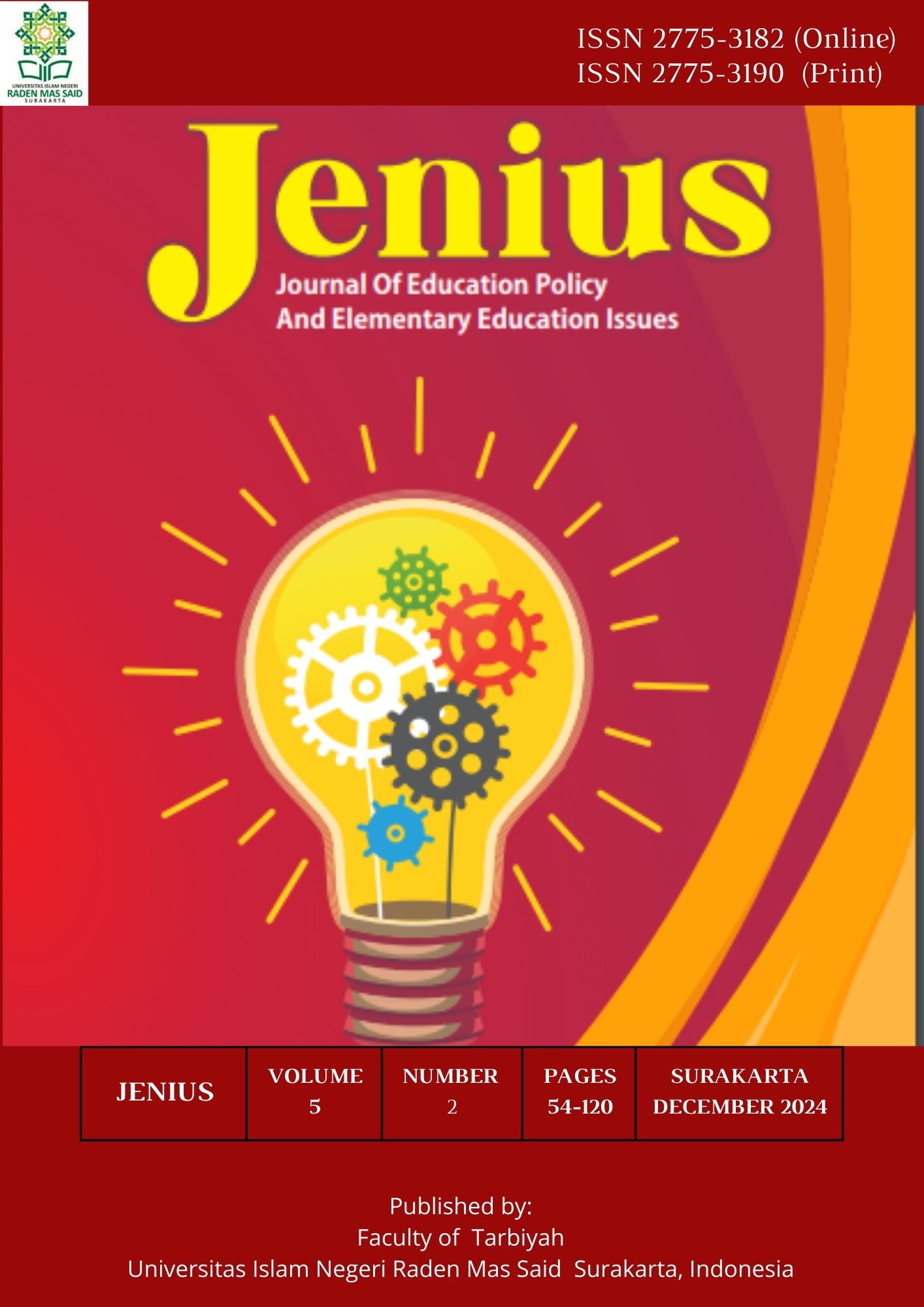Analysis of Learning Barriers and Elementary School Students' Errors in Solving Mathematical Story Problems
Main Article Content
Keywords
Learnimg obstacles, student mistakes, Mathematical word problems, Newman's Theory
Abstract
The errors made by students can be used as a benchmark for students' understanding of the material. This study aims to determine the obstacles to students' learning in solving mathematical story problems based on Brousseau & Balacheff's theory, to find out students' errors in solving mathematical story problems based on Newman's Error Analysis theory, and the factors that cause students to make mistakes in solving mathematical story problems. This research was conducted at MI GUPPI Wironanggan from September 2023 to March 2024. The subjects of this study were grade V students. The type of research is qualitative. Data collection used semi-structured interviews and observations. This study uses supporting instruments like mathematical story problems on speed and discharge material. The data analysis technique uses source triangulation and technique triangulation. The results of this study are the existence of learning obstacles experienced by students, including Ontogenic Obstacles, Didactic Obstacles, and Epistemological Obstacles; the errors made by students include errors in reading, understanding, transforming, and concluding. Several factors that cause student errors include low accuracy in solving problems, not memorizing formulas and not understanding their use, and low student ability in performing arithmetic operations. Based on the study results, teachers are expected to increase the intensity of giving varied questions at various levels
Downloads
References
Brousseau, G., & Balacheff, N. (1988). Théorie des situations didactiques: Didactique des mathématiques 1970-1990. La Penséesauvage. https://cir.nii.ac.jp/crid/1130282271889961216
De Bock, D., Van Dooren, W., Janssens, D., & Verschaffel, L. (2002). Improper use of linear reasoning: An in-depth study of the nature and the irresistibility of secondary school students' errors. Educational studies in mathematics, 50, 311-334. https://link.springer.com/article/10.1023/a:1021205413749
Dewi, L. S. K., Yanti, A. F., Ramadhani, C S., Murniati, S., Astuti, W. (2023). Strategy for learning space geometry concepts in elementary school students. Jenius: Journal of Education Policy and Elementary Education Issues, 4(2), 93-106. https://doi.org/10.22515/jenius.v4i2.6420
Dwidarti, U., Mampouw, H. L., & Setyadi, D. (2019). Analisis kesulitan siswa dalam menyelesaikan soal cerita pada materi himpunan. Jurnal Cendekia: Jurnal Pendidikan Matematika, 3(2), 315-322. https://doi.org/10.31004/cendekia.v3i2.110
Fauzi, I., & Suryadi, D. (2020). The analysis of students' learning obstacles on the fraction addition material for five graders of elementary schools. Al Ibtida: Jurnal Pendidikan Guru MI, 7(1), 33–45. https://doi.org/10.24235/al.ibtida.snj.v7i1.6020
Fuadiah, N. F. (2016). Miskonsepsi sebagai hambatan belajar siswa dalam memahami matematika. Jurnal Ilmu Pendidikan (JIP) STKIP Kusuma Negara, 7(2), 87-92. https://jurnal.stkipkusumanegara.ac.id/index.php/jip/article/view/156
Goldin, G. A. (1998). Representational systems, learning, and problem solving in mathematics. The Journal of Mathematical Behavior, 17(2), 137-165. https://doi.org/10.1016/S0364-0213(99)80056-1
Hamalik, O. (2015). Kurikulum dan pembelajaran. Bumi Aksara. https://senayan.iain-palangkaraya.ac.id/akasia/index.php?p=show_detail&id=4242&keywords=
Harahap, Z. I. S., Muchlis, E. E., & Maulidiya, D. (2019). Faktor – faktor penyebab kesalahan siswa dalam menyelesaikan soal matematika tentang luas permukaan kubus dan balok kelas viii smpn 18 kota bengkulu. Jurnal Penelitian Pembelajaran Matematika Sekolah (JP2MS), 3(3), 342–352. https://doi.org/10.33369/jp2ms.3.3.342-352
Hiebert, J., & Grouws, D. A. (2007). The effects of classroom mathematics teaching on students' learning. International Handbook of Research on Mathematics Teaching and Learning, 371-403.
Laily, I. F. (2014). Hubungan kemampuan membaca pemahaman dengan kemampuan memahami soal cerita matematika sekolah dasar. Eduma : Mathematics Education Learning and Teaching, 3(1), 52–62. https://doi.org/10.24235/eduma.v3i1.8
Lutvaidah, U., & Hidayat, R. (2019). Pengaruh ketelitian membaca soal cerita terhadap kemampuan pemecahan masalah matematika. JKPM (Jurnal Kajian Pendidikan Matematika), 4(2), 179–188. https://doi.org/10.30998/jkpm.v4i2.4189
NCTM. (2000). Principles and standards for school mathematics. National Council of Teachers of Mathematics. https://www.nctm.org/Standards-and-Positions/Principles-and-Standards/
Noviantii, E., Yuanita, P., & Maimunah, M. (2020). Pembelajaran berbasis masalah dalam meningkatkan kemampuan pemecahan masalah matematika. Journal of Education and Learning Mathematics Research (JELMaR), 1(1), 65-73. https://doi.org/10.37303/jelmar.v1i1.12
Rejeki, S., & Sari, Y. R. (2021). Analisis kesalahan berdasarkan teori newman dalam menyelesaikan soal cerita materi pecahan pada siswa kelas VII. Educatif Journal of Education Research, 3(4), 1-12. https://doi.org/10.36654/educatif.v3i4.74
Retnowati, E., Ayres, P., & Sweller, J. (2018). Collaborative learning effects when students have complete or incomplete knowledge. Applied Cognitive Psychology, 32(6), 681-692. https://doi.org/10.1002/acp.3444
Rohmah, M., & Sutiarso, S. (2018). Analysis problem solving in mathematical using theory Newman. Eurasia Journal of Mathematics, Science and Technology Education, 14(2), 671-681. https://doi.org/10.12973/ejmste/80630
Rohmah, S. N. (2021). Strategi pembelajaran matematika. Yogyakarta: UAD PRESS.
Sari, R. A., & Najwa, W. A. (2021). Analisis kesalahan siswa dalam menyelesaikan penjumlahan bilangan bulat berdasarkan teori kastolan. Jurnal Sekolah Dasar, 6(1), 77–83. https://doi.org/10.36805/jurnalsekolahdasar.v6i1.1288
Savitri, D. A., & Yuliani, A. (2020). Analisis kesalahan siswa dalam menyelesaikan permasalahan trigonometri ditinjau dari gender berdasarkan newman. Jurnal Pembelajaran Matematika Inovatif, 3(5), 463–474. https://doi.org/10.22460/jpmi.v3i5.463-474
Setiawan, Y. E. (2020). Analisis kesalahan siswa dalam menilai kebenaran suatu pernyataan. Jurnal Didaktik Matematika, 7(1), 13–31. https://doi.org/10.24815/jdm.v7i1.14495
Sudrajat, A. K., Sari, D. A. W., & Anggrella, D. P. (2023). Hubungan antara faktor eksternal dan internal selama pembelajaran daring pada siswa sekolah menengah. SAP (Susunan Artikel Pendidikan), 8(1), 121-130.http://dx.doi.org/10.30998/sap.v8i1.17089
Ulfa, N., Jupri, A., & Turmudi, T. (2021). Analisis hambatan belajar pada materi pecahan. Research and Development Journal of Education, 7(2), 226–236. https://doi.org/10.30998/rdje.v7i2.8509
Utari, D. R., Wardana, M. S. Y., & Damayani, A. T. (2019). Analisis kesulitan belajar matematika dalam menyelesaikan soal cerita. Jurnal Ilmiah Sekolah Dasar, 3(4), 534–540. https://doi.org/10.51494/jpdf.v4i1.845
Wicaksono, B. (2021). Analisis newman's error penyelesaian soal-soal pada materi persamaan linear dua variabel berbasis kemampuan berpikir kritis matematis berdasarkan gaya kognitif dan habits of mind siswa (Doctoral dissertation, UNIVERSITAS ISLAM NEGERI SULTAN SYARIF KASIM RIAU). https://repository.uin-suska.ac.id/50531/


